Early stages of predatory beetles. From left: larva of carabid ground beetle, centre: two cannibal larval harlequin ladybirds eating another. Right: pupa of 7-spot ladybird.
Role of predatory land beetles in gardens
Ground beetles, rove beetles, ladybirds and their larval stages prey on a wide range of insects and other invertebrate animals in the soil and on plants. Some of these prey items, such as aphids, are significant pests of garden plants. A ladybird, Cryptolaemus montrouzeri, can be purchased to control mealybugs in greenhouses. A rove beetle Atheta coriaria, is similarly available for the control of fungus gnat/sciarid fly larvae.
Since the arrival of the harlequin ladybird, some native ladybird species seem to have declined in numbers. This may be the result of competition for food resources, or through predation by the harlequin ladybird of native ladybird species. The two-spot ladybird is the species that has shown the greatest reduction in abundance.
Other sources of information
Website of the UK Ladybird Survey
Website on Irish ground beetles
Mark Telfer's website on staphylinid beetles
Mark Telfer's website on carabid beetles
Books
Forsythe, T. G. (2000) Naturalists' Handbooks 8 Ground Beetles. Richmond Publishing
Lott, D. A. (2009). Handbooks for the identification of British insects, vol. 12, part 5 The Staphylinidae (rove beetles) of Britain and Ireland. Part 5: Scaphidiinae, Piestinae, Oxytelinae. Royal Entomological Society
Lott, D. A. and Anderson, R. (2011). Handbooks for the identification of British insects, vol. 12, part 7 The Staphylinidae (rove beetles) of Britain and Ireland. Parts 7 & 8: Oxyporinae, Steninae, Euaesthetinae, Pseudopsinae, Paederinae, Staphylininae. Royal Entomological Society.
Luff, M. L. (2007) Handbooks for the Identification of British Insects Vol 4 part 2 The Carabidae (ground beetles) of Britain and Ireland. Royal Entomological Society
Majerus, M. E. N. (1994) Ladybirds Collins New Naturalist series no. 81. Harper Collins
Roy, H., Brown, P., Frost, A. & Poland, R. (2011) Ladybirds (Coccinellidae) of Britain and Ireland. Field Studies Council
Roy, H., Brown, P., Comont, R., Frost, A., Poland, R. & Sloggett, J. (2013) Naturalists' Handbooks 10 Ladybirds. Pelagic Publishing
By Andrew Halstead reviewed by Andrew Salisbury edited by Steve Head
Predatory Land Beetles
The principal beetle families that have predatory adults and larvae in gardens are the Carabidae or ground beetles, the Staphylinidae or rove beetles, and the Coccinellidae or ladybirds.
![By Ian Alexander [CC BY-SA 4.0 (https://creativecommons.org/licenses/by-sa/4.0)], from Wikimedia Commons](images/Devils coach horse.jpg)
.jpg)
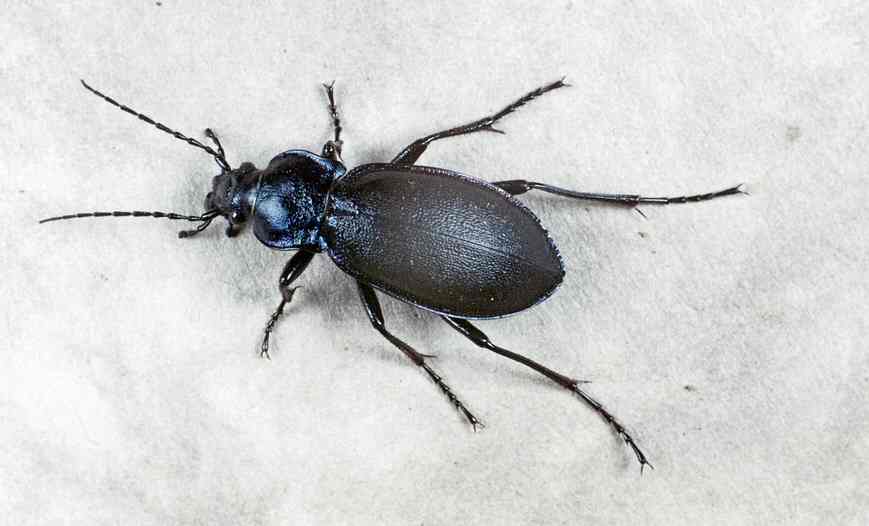
Representative species from the three main families. Left: a typical carabid, the common violet ground beetle Carabus violaceus. Centre: the staphylinid devil's coach horse beetle Ocypus olens (previously Staphylinus olens) and on the right the coccinellid 7-spot ladybird beetle Coccinella septempunctata.
Species in Britain and Ireland
There are about 350 species of ground beetles, also known as carabids, in Britain and Ireland. Some are common in gardens where they are likely to be found hiding under logs, stones and plant pots.
Rove beetles, also known as staphs or staphylinids, are the largest beetle family in the British Isles with more than 900 species recorded. They live in the soil but some are found in compost heaps, in dung, on fungi or in bird nests.
Ladybirds number about 50 species, which include some introduced species that occur mainly in glasshouses.
Biology of ground beetles
Ground beetles range in size from 3-22mm in length. They are mostly black but some are green or yellowish brown. The adults have long slender legs and can run at speed. They mostly live at ground level but some will climb up plants where they prey on aphids, caterpillars and other insects. Some, such as Harpalus species, will eat seeds as adults. Most species are predators of soil-dwelling invertebrates. The larger ground beetles, such as Carabus, Nebria and Pterostichus species will feed on larger insects, slugs and earthworms. Cychrus caraboides specialises in feeding on snails. Jennifer Owen recorded 32 species of carabids in her garden.
The smaller ground beetles, such as Bembidion and Notiophilus species, feed on small soil-dwelling insects, including springtails. The larvae of ground beetles are also predatory and live in the soil.
![By gailhampshire from Cradley, Malvern, U.K (Nebria brevicollis or N. salina) [CC BY 2.0 (https://creativecommons.org/licenses/by/2.0)], via Wikimedia Commons](images/751px-Nebria_brevicollis crop.jpg)
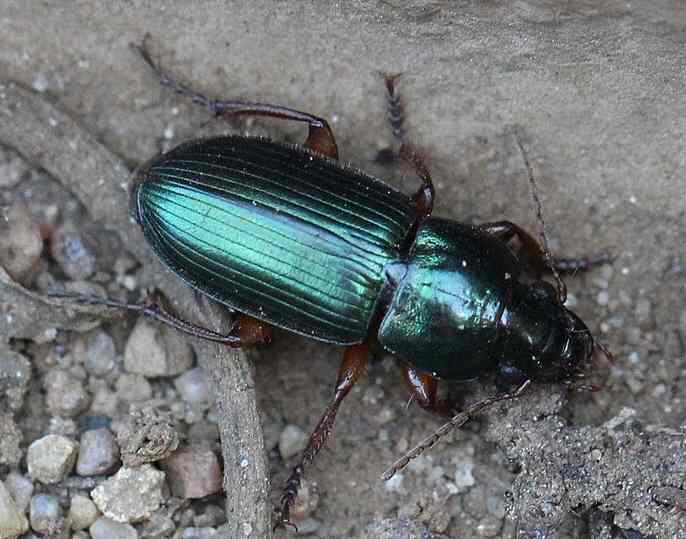
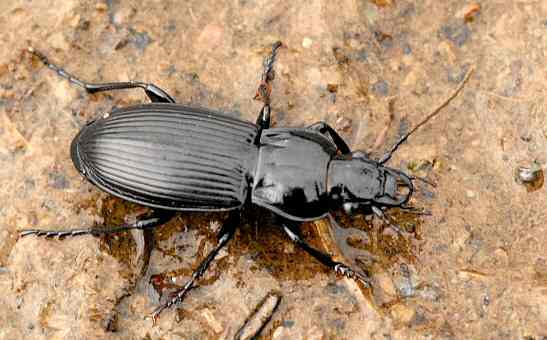
Above - Harpalus affinis Centre: Nebria brevicollis (or N.salina) and right: Pterostichus niger
Below - Cychrus caraboides Centre Bembidion tetracolum and right Notiophilus.biguttatus
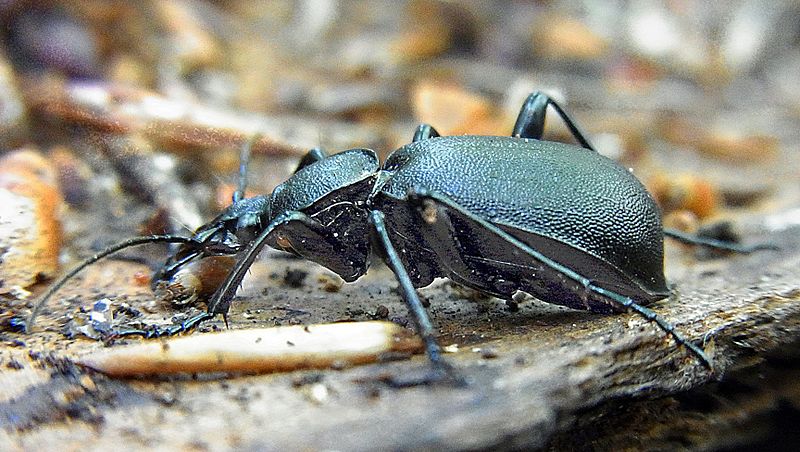
![By Udo Schmidt from Deutschland [CC BY-SA 2.0 (https://creativecommons.org/licenses/by-sa/2.0)], via Wikimedia Commons](images/Bembidion_tetracolum_Say.jpg)
![James Lindsey at Ecology of Commanster [CC BY-SA 2.5 (https://creativecommons.org/licenses/by-sa/2.5) or CC BY-SA 3.0 (https://creativecommons.org/licenses/by-sa/3.0)], via Wikimedia Commons](images/Notiophilus.biguttatus.-.lindsey.jpg)
Biology of rove beetles
Rove beetles in the family Staphylinidae have short, square ended wing cases that cover only the front part of the abdomen. They are elongate beetles that range in size from 2-25mm. One of the largest is the devil’s coach horse, Ocypus olens, which can often be found hiding during the day under logs or stones. As with ground beetles, the adults and larvae of rove beetles feed on a wide range of soil-dwelling invertebrate animals.
Jennifer Owen recorded 141 species of staphylinids in her Leicester garden, 20 were caught by falling into pitfall traps and another 121 species were caught while flying, in a malaise trap.
![By Daniel Ullrich, Threedots [GFDL (http://www.gnu.org/copyleft/fdl.html), CC-BY-SA-3.0 (http://creativecommons.org/licenses/by-sa/3.0/) or CC BY-SA 2.0 de (https://creativecommons.org/licenses/by-sa/2.0/de/deed.en)], from Wikimedia Commons](images/Ocypus olens.jpg)
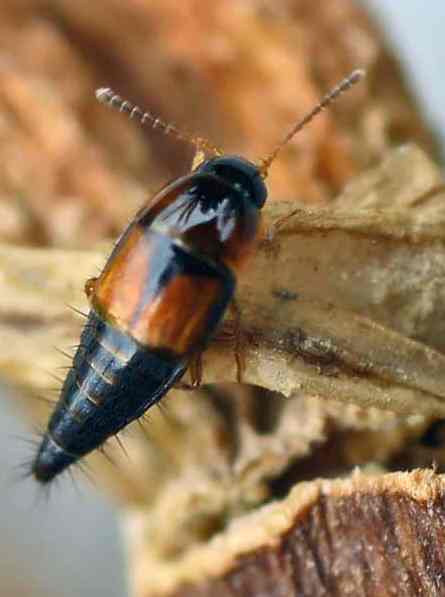
Left: Devil's coach horse rove beetle, in characteristic defensive stance with abdomen raised to look like a sting.
Right: Tachyporus hypnorum a typical 3-4mm rove beetle. This was by far the commonest beetle in Jennifer Owen's garden.
Biology of ladybirds
Ladybirds are the most familiar predatory beetles in gardens. Some, such as the 7-spot ladybird, Coccinella 7-punctata, 2-spot ladybird, Adalia 2-punctata and 10-spot ladybird, Adalia 10-punctata are common aphid predators in gardens. Since 2004 they have been joined by an invasive species that originates from Japan. This is the harlequin ladybird, Harmonia axyridis, which in much of Britain is now the most abundant ladybird, especially by late summer. Jennifer Owen recorded 13 species in her garden.
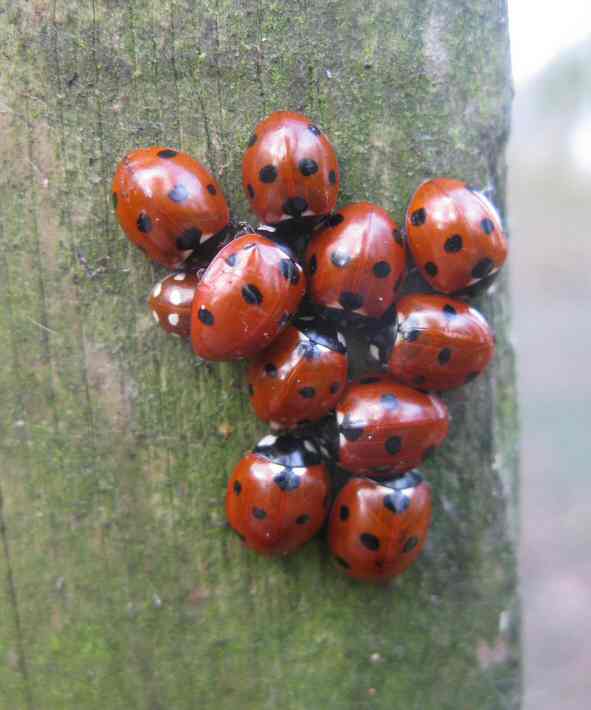
![By David Short from Windsor, UK (2-spot ladybird) [CC BY 2.0 (https://creativecommons.org/licenses/by/2.0)], via Wikimedia Commons](images/2-spot_ladybird.jpg)
![By S. Rae from Scotland, UK [CC BY 2.0 (https://creativecommons.org/licenses/by/2.0)], via Wikimedia CommonsBy S. Rae from Scotland, UK [CC BY 2.0 (https://creativecommons.org/licenses/by/2.0)], via Wikimedia Commons](images/Adalia_decempunctata.jpg)
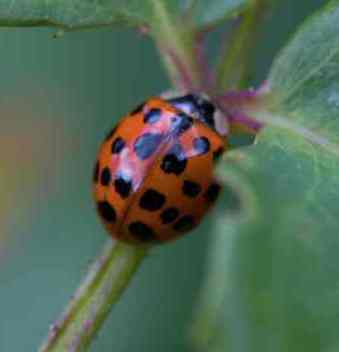
Above, from the left: Hibernating 7-spot ladybirds, 2-spot ladybird, 10-spot ladybird and the harlequin ladybird. Most ladybirds, especially the harlequin and 10-spot, have extremely variable patterns, and counting spots is not a reliable guide to species!
Some ladybirds, such as the kidney spot ladybird, Chilocorus renipustulatus, and pine ladybird, Exochomus 4-pustulatus, specialise in feeding on scale insects. A 2mm long, all black ladybird, Stethorus punctillum, is a predator of red spider mites. The larval stages of ladybirds have similar diets to the adults.
![By gailhampshire from Cradley, Malvern, U.K (Exochomus 4-pustulatus. Pine Ladybird.) [CC BY 2.0 (https://creativecommons.org/licenses/by/2.0)], via Wikimedia Commons](images/Pine_Ladybird.jpg)
![By Gilles San Martin [CC BY-SA 2.0 (https://creativecommons.org/licenses/by-sa/2.0)], via Wikimedia Commons](images/Stethorus_punctillum2.jpg)
From left: Chilocorus renipustulatus feeding on Euonymus scale insects, Exochomus 4-pustulatus, and Stethorus punctillum
Some ladybirds found in gardens are not predatory. Orange ladybird, Halyzia 16-guttata, and 22-spot ladybird, Psyllobora 22-punctata, feed on fungi known as powdery mildews. There are also some plant-eating ladybirds, such as the 24-spot ladybird, Subcoccinella 24-punctata, which eats the foliage of red campion, and bryony ladybird, Henosepilachna argus, which eats the foliage of white bryony.
.jpg)
![By S. Rae from Scotland, UK (Halyzia 16-guttata (Orange ladybird)) [CC BY 2.0 (https://creativecommons.org/licenses/by/2.0)], via Wikimedia Commons](images/Halyzia_16-guttata.jpg)
![By AJC1 from UK [CC BY-SA 2.0 (https://creativecommons.org/licenses/by-sa/2.0)], via Wikimedia Commons](images/544px-24_Spot_Ladybird.jpg)
![By Katja Schulz from Washington, D. C., USA (Bryony Ladybird) [CC BY 2.0 (https://creativecommons.org/licenses/by/2.0)], via Wikimedia Commons](images/Bryony_Ladybird.jpg)
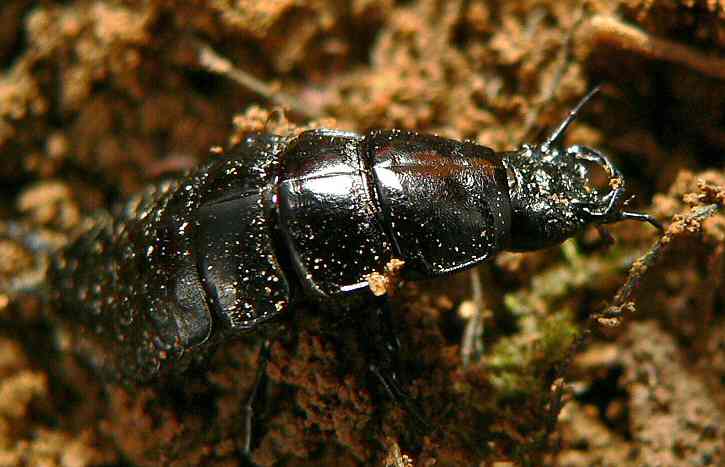
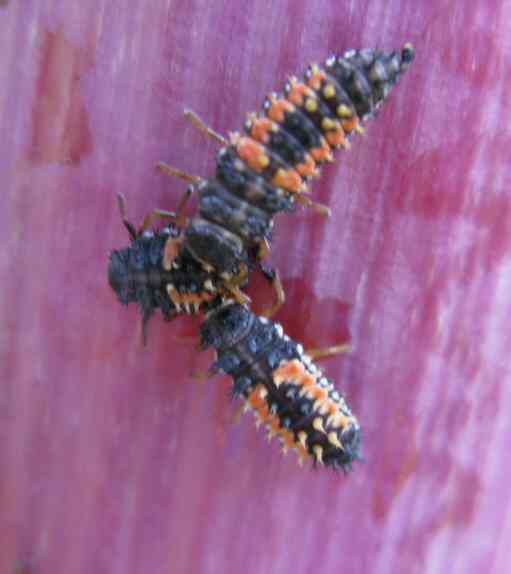
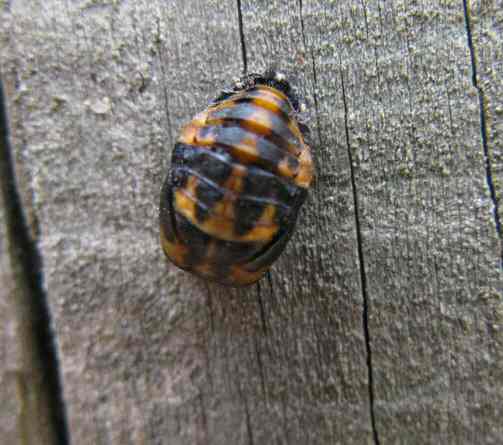
Predatory Land Beetles
The principal beetle families that have predatory adults and larvae in gardens are the Carabidae or ground beetles, the Staphylinidae or rove beetles, and the Coccinellidae or ladybirds.

![By Ian Alexander [CC BY-SA 4.0 (https://creativecommons.org/licenses/by-sa/4.0)], from Wikimedia Commons](images/Devils coach horse.jpg)
.jpg)
Early stages of predatory beetles. From left: larva of carabid ground beetle, centre: two cannibal larval harlequin ladybirds eating another. Right: pupa of 7-spot ladybird.
Role of predatory land beetles in gardens
Ground beetles, rove beetles, ladybirds and their larval stages prey on a wide range of insects and other invertebrate animals in the soil and on plants. Some of these prey items, such as aphids, are significant pests of garden plants. A ladybird, Cryptolaemus montrouzeri, can be purchased to control mealybugs in greenhouses. A rove beetle Atheta coriaria, is similarly available for the control of fungus gnat/sciarid fly larvae.
Since the arrival of the harlequin ladybird, some native ladybird species seem to have declined in numbers. This may be the result of competition for food resources, or through predation by the harlequin ladybird of native ladybird species. The two-spot ladybird is the species that has shown the greatest reduction in abundance.
Other sources of information
Website of the UK Ladybird Survey
Website on Irish ground beetles
Mark Telfer's website on staphylinid beetles
Mark Telfer's website on carabid beetles
Books
Forsythe, T. G. (2000) Naturalists' Handbooks 8 Ground Beetles. Richmond Publishing
Lott, D. A. (2009). Handbooks for the identification of British insects, vol. 12, part 5 The Staphylinidae (rove beetles) of Britain and Ireland. Part 5: Scaphidiinae, Piestinae, Oxytelinae. Royal Entomological Society
Lott, D. A. and Anderson, R. (2011). Handbooks for the identification of British insects, vol. 12, part 7 The Staphylinidae (rove beetles) of Britain and Ireland. Parts 7 & 8: Oxyporinae, Steninae, Euaesthetinae, Pseudopsinae, Paederinae, Staphylininae. Royal Entomological Society.
Luff, M. L. (2007) Handbooks for the Identification of British Insects Vol 4 part 2 The Carabidae (ground beetles) of Britain and Ireland. Royal Entomological Society
Majerus, M. E. N. (1994) Ladybirds Collins New Naturalist series no. 81. Harper Collins
Roy, H., Brown, P., Frost, A. & Poland, R. (2011) Ladybirds (Coccinellidae) of Britain and Ireland. Field Studies Council
Roy, H., Brown, P., Comont, R., Frost, A., Poland, R. & Sloggett, J. (2013) Naturalists' Handbooks 10 Ladybirds. Pelagic Publishing
By Andrew Halstead reviewed by Andrew Salisbury edited by Steve Head
Species in Britain and Ireland
There are about 350 species of ground beetles, also known as carabids, in Britain and Ireland. Some are common in gardens where they are likely to be found hiding under logs, stones and plant pots.
Rove beetles, also known as staphs or staphylinids, are the largest beetle family in the British Isles with more than 900 species recorded. They live in the soil but some are found in compost heaps, in dung, on fungi or in bird nests.
Ladybirds number about 50 species, which include some introduced species that occur mainly in glasshouses.
Biology of ground beetles
Ground beetles range in size from 3-22mm in length. They are mostly black but some are green or yellowish brown. The adults have long slender legs and can run at speed. They mostly live at ground level but some will climb up plants where they prey on aphids, caterpillars and other insects. Some, such as Harpalus species, will eat seeds as adults. Most species are predators of soil-dwelling invertebrates. The larger ground beetles, such as Carabus, Nebria and Pterostichus species will feed on larger insects, slugs and earthworms. Cychrus caraboides specialises in feeding on snails. Jennifer Owen recorded 32 species of carabids in her garden.
The smaller ground beetles, such as Bembidion and Notiophilus species, feed on small soil-dwelling insects, including springtails. The larvae of ground beetles are also predatory and live in the soil.
Representative species from the three main families. Top left: a typical carabid, the common violet ground beetle Carabus violaceus. Right: the staphylinid devil's coach horse beetle Ocypus olens (previously Staphylinus olens) and below left the coccinellid 7-spot ladybird beetle Coccinella septempunctata.


![By gailhampshire from Cradley, Malvern, U.K (Nebria brevicollis or N. salina) [CC BY 2.0 (https://creativecommons.org/licenses/by/2.0)], via Wikimedia Commons](images/751px-Nebria_brevicollis crop.jpg)
Harpalus affinis Nebria brevicollis (or N.salina) Pterostichus niger
Cychrus caraboides Bembidion tetracolum Notiophilus.biguttatus
![James Lindsey at Ecology of Commanster [CC BY-SA 2.5 (https://creativecommons.org/licenses/by-sa/2.5) or CC BY-SA 3.0 (https://creativecommons.org/licenses/by-sa/3.0)], via Wikimedia Commons](images/Notiophilus.biguttatus.-.lindsey.jpg)
![By Udo Schmidt from Deutschland [CC BY-SA 2.0 (https://creativecommons.org/licenses/by-sa/2.0)], via Wikimedia Commons](images/Bembidion_tetracolum_Say.jpg)

Biology of rove beetles
Rove beetles in the family Staphylinidae have short, square ended wing cases that cover only the front part of the abdomen. They are elongate beetles that range in size from 2-25mm. One of the largest is the devil’s coach horse, Ocypus olens, which can often be found hiding during the day under logs or stones. As with ground beetles, the adults and larvae of rove beetles feed on a wide range of soil-dwelling invertebrate animals.
Jennifer Owen recorded 141 species of staphylinids in her Leicester garden, 20 were caught by falling into pitfall traps, and another 121 species were caught while flying, in a malaise trap.
Left: Devil's coach horse rove beetle, in characteristic defensive stance with abdomen raised to look like a sting. Right: Tachyporus hypnorum a typical 3-4mm rove beetle. This was by far the commonest beetle in Jennifer Owen's garden.

![By Daniel Ullrich, Threedots [GFDL (http://www.gnu.org/copyleft/fdl.html), CC-BY-SA-3.0 (http://creativecommons.org/licenses/by-sa/3.0/) or CC BY-SA 2.0 de (https://creativecommons.org/licenses/by-sa/2.0/de/deed.en)], from Wikimedia Commons](images/Ocypus olens.jpg)

![By S. Rae from Scotland, UK [CC BY 2.0 (https://creativecommons.org/licenses/by/2.0)], via Wikimedia CommonsBy S. Rae from Scotland, UK [CC BY 2.0 (https://creativecommons.org/licenses/by/2.0)], via Wikimedia Commons](images/Adalia_decempunctata.jpg)
![By David Short from Windsor, UK (2-spot ladybird) [CC BY 2.0 (https://creativecommons.org/licenses/by/2.0)], via Wikimedia Commons](images/2-spot_ladybird.jpg)

Biology of ladybirds
Ladybirds are the most familiar predatory beetles in gardens. Some, such as the 7-spot ladybird, Coccinella 7-punctata, 2-spot ladybird, Adalia 2-punctata and 10-spot ladybird, Adalia 10-punctata are common aphid predators in gardens. Since 2004 they have been joined by an invasive species that originates from Japan. This is the harlequin ladybird, Harmonia axyridis, which in much of Britain is now the most abundant ladybird, especially by late summer. Jennifer Owen recorded 13 species in her garden.
Above, from the left: Hibernating 7-spot ladybirds, 2-spot ladybird, 10-spot ladybird and the harlequin ladybird. Most ladybirds, especially the harlequin and 10-spot, have extremely variable patterns, and counting spots is not a reliable guide to species!
Some ladybirds, such as the kidney spot ladybird, Chilocorus renipustulatus, and pine ladybird, Exochomus 4-pustulatus, specialise in feeding on scale insects. A 2mm long, all black ladybird, Stethorus punctillum, is a predator of red spider mites. The larval stages of ladybirds have similar diets to the adults.
.jpg)
![By Gilles San Martin [CC BY-SA 2.0 (https://creativecommons.org/licenses/by-sa/2.0)], via Wikimedia Commons](images/Stethorus_punctillum2.jpg)
![By gailhampshire from Cradley, Malvern, U.K (Exochomus 4-pustulatus. Pine Ladybird.) [CC BY 2.0 (https://creativecommons.org/licenses/by/2.0)], via Wikimedia Commons](images/Pine_Ladybird.jpg)
From left: Chilocorus renipustulatus feeding on Euonymus scale insects, Exochomus 4-pustulatus, and Stethorus punctillum
Some ladybirds found in gardens are not predatory. Orange ladybird, Halyzia 16-guttata, and 22-spot ladybird, Psyllobora 22-punctata, feed on fungi known as powdery mildews. There are also some plant-eating ladybirds, such as the 24-spot ladybird, Subcoccinella 24-punctata, which eats the foliage of red campion, and bryony ladybird, Henosepilachna argus, which eats the foliage of white bryony.
![By S. Rae from Scotland, UK (Halyzia 16-guttata (Orange ladybird)) [CC BY 2.0 (https://creativecommons.org/licenses/by/2.0)], via Wikimedia Commons](images/Halyzia_16-guttata.jpg)
![By AJC1 from UK [CC BY-SA 2.0 (https://creativecommons.org/licenses/by-sa/2.0)], via Wikimedia Commons](images/544px-24_Spot_Ladybird.jpg)
![By Katja Schulz from Washington, D. C., USA (Bryony Ladybird) [CC BY 2.0 (https://creativecommons.org/licenses/by/2.0)], via Wikimedia Commons](images/Bryony_Ladybird.jpg)
Halyzia 16-guttata Subcoccinella 24-punctata Henosepilachna argus
Life cycle
Ground beetles and rove beetles deposit their eggs in the soil, while ladybirds lay clusters of pale yellow eggs on plants. The larvae pass through several instars before they are fully fed. Those of ground beetles and rove beetles pupate in the soil. Fully fed ladybird larvae pupate in exposed positions on foliage, tree trunks or garden fences. Most ground beetles, rove beetles and ladybirds have one generation a year. The harlequin ladybird, however, can have at least three generations, which is one reason why it is so abundant by late summer. Ladybirds overwinter as adults in sheltered places. Some species do so clustered together in large numbers. The harlequin and 2-spot ladybirds often seek shelter in houses and outbuildings.



From left: Halyzia 16-guttata Subcoccinella 24-punctata and Henosepilachna argus
Life cycle
Ground beetles and rove beetles deposit their eggs in the soil, while ladybirds lay clusters of pale yellow eggs on plants. The larvae pass through several instars before they are fully fed. Those of ground beetles and rove beetles . pupate in the soil. Fully fed ladybird larvae pupate in exposed positions on foliage, tree trunks or garden fences. Most ground beetles, rove beetles and ladybirds have one generation a year. The harlequin ladybird, however, can have at least three generations, which is one reason why it is so abundant by late summer. Ladybirds overwinter as adults in sheltered places. Some species do so clustered together in large numbers. The harlequin and 2-spot ladybirds often seek shelter in houses and outbuildings.












